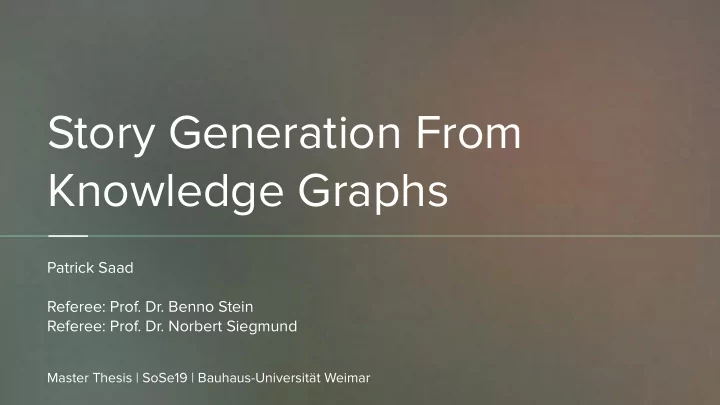

Story Generation From Knowledge Graphs Patrick Saad Referee: Prof. Dr. Benno Stein Referee: Prof. Dr. Norbert Siegmund Master Thesis | SoSe19 | Bauhaus-Universität Weimar
The Research Problem Knowledge Graph Document Collection MATCH (a:Author)-[r1:AUTHOR_IN]->(p1:Paper)-[r2:CITED_BY]->(p2:Paper) Keyword query to graph query WHERE p1.year = 2019 WITH a, r1, p1, r2, p2 RETURN a.name AS author, count(r2) AS total ORDER BY total DESC Query Language (Cypher, SPARQL) Intuitive Hard Coherent Raw Results Text Story Generation Subjective Objective Maybe Available Unavailable Google Search Making search knowledge graphs like google.com searching the web Query Results 1
Related Work | Faceted Search Interfaces Provide users with a visual method to formulating queries using facets Query Languages Knowledge Graph Facets User Faceted Search Query Results 2
Related Work | Faceted Search Interfaces Faceted search interfaces provides query simplification using facets Complex queries are still hard to formulate (Author + Year + ”Top”) Filtered results contain implicit insights Semantic Scholar semanticscholar.com 3
Related Work | Social Network Analysis, Distant Reading Find relationship patterns, influential entities, outliers Distant Reading | Influential Authors In Literature Illustration by Joon Mo Kang, Stanford Literary Lab Social Network Analysis | Centrality, Louvain Algorithm, etc.. Wolfram Alpha - wolframalpha.com 4
Related Work | Automated Journalism Automatically generate stories from data Natural Language Processing ➔ Natural Language Generation ➔ Story Templates ➔ 750 000 articles Problems Facets such as Location, Candidate, ➔ News reporting without in-depth analysis or Party Insights are still implicit (influential entities?) ➔ Valtteri, the Finnish Municipal Election Bot vaalibotti.fi 5
Story Generation Framework | Use Case Knowledge Graph Setup Semantic Scholar Open Research Corpus 45 million papers (Computer Science, Neuroscience, Biomedical) (1) Select all papers with a specific author A A (2) Recursively get incoming/outgoing citations Our graph model 549,066 Papers, 8124 A Authors and 632 Journals Subset from our knowledge graph built using Neo4j 2 and Cypher 3 2 Neo4j https://neo4j.com 3 Cypher https://neo4j.com/developer/cypher-query-language 6
Story Generation Framework | Use Case Insight Discovery Construct graph queries that compute social performance and influence metrics Neo4j’s graph algorithms library 1 Betweenness Centrality, PageRank, etc.. Total Direct Relationships Paper Citations, Author Collaborations, etc.. Statistics from facets of directly connected nodes Total/Min/Max/Avg Author h-index, Paper Citations, etc.. Total Indirect Relationships Discovering insights from Nested Paper Citations, Nested Author Collaborations, etc.. social relationships 1 https://neo4j.com/developer/graph-algorithms 7
Story Generation Framework | Use Case Story Generation Automatically generate stories to communicate the insights Paper Author Journal Total Story Types Numerical facet 4 different story types based on the available facets 8 5 9 22 analysis Time-filtered Story Templates numerical facet 448 0 0 488 Story 2 templates analysis Types Story Content Numerical facet 28 10 36 74 correlation analysis Introduction Data overview using statistics Weaver performance 1 1 1 3 Top performing entities analysis Plot graphs Total 485 16 46 547 Total stories by story type for different entity types 8
Weaver User Interface | Search Knowledge Box provides additional graph insights Example Story Template | Search Results and Knowledge Box 13
Weaver User Interface | Knowledge Box Top Connected Entities Separate entity ranking for every social metric Example Story Template | Search Results - Knowledge Box and all facet ranks 14
Weaver User Interface | Knowledge Box Community impact from several aspects Different insights can reveal different kinds of social influence 15
Weaver User Interface | Story Templates weaver.webis.de 9
Weaver User Interface | Story Templates Title Introduction (Dataset info, Metric description) Title and Introduction sections 10
Weaver User Interface | Story Templates Statistical Overview Data Overview section 11
Weaver User Interface | Story Templates Entities ranked by their facet performance Interconnected Stories, Entities, and Search Results via hyperlinks Top performing entities section 12
Story Generation Framework | Use Case Evaluation using CSUQ Strongly disagree Strongly agree -3 -2 1 0 1 2 3 5 participants (expert users) Question Category Mean Standard Deviation System Use 1.28 0.40 (questions 1-8) Information Quality 0.72 0.33 (questions 9-15) Interface Quality 1.07 0.22 (questions 16-18) Overall (questions 1 1.70 0.04 and 19) 16
Story Generation From Knowledge Graphs Future Work Bigger knowledge graph using the cluster (more resources, framework modifications) Generate additional insights (social network analysis, graph theory, etc..) Improve story titles and content (natural language generation, interactive storytelling, ) Improve the search interface (keyword query to graph query, iterative usability testing) Better search results ranking 17
Story Generation from Knowledge Graphs Patrick Saad Referee: Prof. Dr. Benno Stein Referee: Prof. Dr. Norbert Siegmund Master Thesis | SoSe19 | Bauhaus-Universität Weimar
Recommend
More recommend